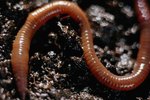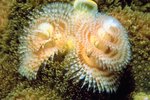
According to biologist E.O. Wilson, four out of every five animals on the planet are nematodes, popularly called roundworms. Their colloquial name describes the smooth, cylindrical creatures well. Despite their unthinkable diversity and ubiquity, all forms of roundworms share a few features, such as their method of respiration. All roundworms, including both free-living and parasitic species, obtain oxygen directly through their skin.
Roundworm Diversity and Abundance
Scientists have formally described about 12,000 species of roundworms, but the total number of living species may be as high as 500,000. If this many species exist, roundworms would represent the second most speciose phylum in the world, trailing only the arthropods. Roundworms inhabit virtually every ecosystem on the planet, from ice sheets to hot springs. Many species live freely in the water or soil, but others are parasitic; they infest plants and animals, including humans. Despite the diversity of the group, all forms have similar general anatomy and respiratory processes.
Roundworm Basics
The vast majority of roundworms are small; many are microscopic. However, one species -- Placentonema gigantissima, a parasite of sperm whales -- reaches nearly 30 feet in length. Their outermost layer, called the cuticle, is constructed of non-cellular tissue and sheds regularly to allow growth. Roundworms have a simple digestive system composed of a mouth, a triangular shaped pharynx, intestines and an anus. Roundworms lack circulatory systems; instead, resources and wastes diffuse through their body cavities. Roundworms have two nerve cords, and one travels along their ventral side, while the other stretches along the dorsal side. These nerves work in conjunction with their longitudinal muscles to propel the worms through their environment.
Roundworm Respiration
Like most animals, roundworms primarily engage in aerobic respiration, meaning that they use oxygen to convert food into energy. However, roundworms do not use lungs to move the oxygen around their bodies. Roundworms absorb oxygen and release carbon dioxide directly through their cuticle, which is permeable to both gases. Once oxygen has crossed into their bodies, it diffuses throughout the tissues. The process of diffusion limits the maximum diameter of roundworms; if they grew much larger, the oxygen would take too long to travel through their bodies.
Life Without Oxygen
In some situations, a roundworm’s environment may become depleted of oxygen. When oxygen resources first begins to diminish, some roundworms reduce their growth rates, thereby reducing their oxygen needs. Other species appear to keep growing in low-oxygen environments, though scientists do not yet understand why. If the oxygen level continues to drop, roundworms will slow their metabolisms even further. In extreme cases, the worms will change their metabolic processes and begin employing fermentative metabolism, which does not require oxygen. If the environment deteriorates further, the worms can enter a state of suspended animation called cryptobiosis. During cryptobiosis, metabolic processes grind to a halt and the worms essentially stops aging. Once good conditions return, the worms end cryptobiosis and become active again.
References
- TED.com: E.O. Wilson: My Wish: Build the Encyclopedia of Life
- Penn State University: Energy and Modes of Nutrition in Nematodes
- University of California, Berkeley: Introduction to the Nematoda
- Animal Diversity Web: Nematoda
- Oregon State University: Nematode Excretory System
- Huffington Post: Parasitic Nematode, or Roundworm, Called Most Numerically Abundant Animal on Earth
Resources
- Polar Biology: Note on Sea-Ice Nematodes (Monhysteroidea) From Resolute Passage, Canadian High Arctic
- Annual Review of Phytopathology: Ecology of Plant and Free-Living Nematodes in Natural and Agricultural Soil
- University of Florida IFAS Extension: Using Nematodes to Control Insects: Overview and Frequently Asked Questions
Photo Credits
-
Duncan Smith/Stockbyte/Getty Images




